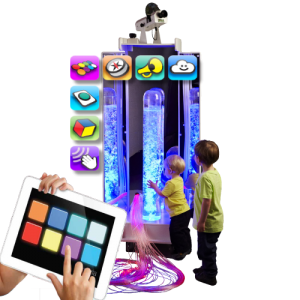Planning A Sensory Room
It’s like a sensory massage. Ahhhhh. Step into a sensory room, or otherwise known as a multisensory environment, and witness the profound effect on an individual in need. Soothing, calming, organizing and orienting are just a few benefits of time well spent in one of these special places.
If you have someone with special needs such as those living with Alzheimers, anxiety, ADHD or ADD, Autism or Sensory Processing Disorder, they may benefit from regular time spent in a sensory room. A closet, basement, bedroom, office, classroom or gym can all be used to create a space that will benefit those you serve. Let's take a look at a few key points when deciding to embark on this journey. Experts are available so don’t hesitate to ask!
- What are the goals of your room? Are you trying to create a calm room? Room for alerting? A time-out space? A waiting area? Or an action space? Do you need help selecting equipment to meet the goals of your room? Are you meeting the needs of individuals with Autism, Aspergers, ADHD, Alzheimers? What age are your clients?
- Location Location Location: Take a look around. Do you have a room allocated for your sensory space? What is the room like now? Are there enough outlets? What about windows? Sensory rooms work best without windows using controlled lighting, though windows can be used if necessary. Is it a noisy location? It’s best if your room is set off in a quiet spot. Can individuals access the room easily?
- Four’s a Crowd. How many people will be using your space? A calming room works best with no more than 3-4 users and individual sessions are even better. A small closet like space should be used by one individual at a time. Remember, though a sensory room can be large, it is not a gym.
- Police Your Room. Who will be supervising your space, checking up on equipment maintenance and keeping it in order? Do they understand the purpose of the room and how to monitor or make adjustments? An orientation to those using and supervising the room is a great idea.
- Sensory rooms can range from a couple hundred to several thousands of dollars. It really depends on your environment and your goals. If you’re building a budget keep in mind that quality equipment is a better investment than off brand. Stick with a company that has a record for sensory room building and knows how to advise, install and hold your hand.

This stylish unit glides easily from one room to another, enabling you to move sensory equipment to where it is needed
If you feel that a sensory room is something you need, but are unsure of how you create the right environment for your requirements, then speak to us at Experia. We have a wealth of knowledge and expertise on the matter.
We are here to assist you!
Call on 0800 612 6077 or send an email to [email protected]
The Experia Team
Original blogpost created by our sister company Experia USA.
-1000x1000.png)
